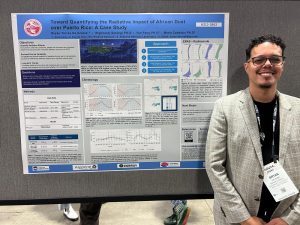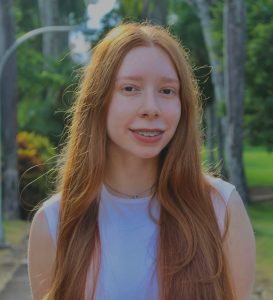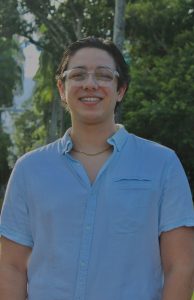 Pamela Denise Acevedo Soto
Pamela Denise Acevedo Soto
email: pamela.acevedo1@upr.edu
Graduate Student
Project Tittle – Investigating Bioaerosol Dynamics: Comparative Analysis of Atmospheric Biological Particles in Puerto Rico and New York
Project Description – Currently pursuing a PhD in Environmental Sciences, I study bioaerosols—biological particles like bacteria and fungi suspended in the atmosphere. My research compares bioaerosol data from Puerto Rico and New York using the Wideband Integrated Bioaerosol Sensor (WIBS-5). During my 2024 summer internship at Brookhaven National Lab, I collected and analyzed samples to examine bioaerosol concentration differences across geographic locations and environmental conditions. I have presented my findings at major conferences, including PRISM 2024, and recently at AGU 2024. My next step is characterizing bacterial bioaerosols, advancing our understanding of their impact on climate and public health.
Collaborators – Brookhaven National Lab

Bryan I Torres De Gracia
email: bryan.torres4@upr.edu
Graduate Student
Project Tittle – African Dust Radiative Forcing over Puerto Rico: A Case Study
Project Description – This study examines the radiative forcing effects of Saharan dust, focusing on the 2020 “Godzilla” dust event in Puerto Rico. Using observational data and the Rapid Radiative Transfer Model (RRTM), the research compares the impacts of dust and non-dust conditions on solar irradiance and climate. It assesses shortwave and longwave radiation changes, diurnal variability, and surface radiation during dust events. By analyzing the effect of Saharan dust transported via the Saharan Air Layer, the study contributes to a better understanding of mineral dust aerosols’ influence on climate and improves climate modeling accuracy.
Collaborators – Dr. Bighnaraj Sarangi (University of Puerto Rico, Rio Piedras); Dr. Yan Feng (Argonne National Laboratory); Dr. Maria Cadeddu (Argonne National Laboratory)

Andrea N. Suárez-Rosado
email: andrea.suarez4@upr.edu
Undergraduate Student
Project Title – Comparative Analysis of Saharan Dust Optical Properties in Houston, Texas and Puerto Rico
Project Description – Dust influences global climate by affecting Earth’s radiative balance through direct and indirect effects. Transported by winds, dust can impact regions far from its source. In Puerto Rico, Saharan dust is prevalent in summer, while Houston experiences Caribbean influences. This study compares Saharan dust’s optical properties—AOD, AE, and SSA—using data from the ARM TRACER Campaign in Houston (October 2021–September 2022) and Cape San Juan Station in Puerto Rico (May 2021–June 2022). The goal is to analyze regional differences in dust properties and their effects on local atmospheric conditions and climate.
Collaborators – Yan Feng and Paytsar Muradyan, Argonne National Laboratory

Ilán J. Nieves Gómez
email: ilan.nieves@upr.edu
Undergraduate Student
Project Title – Exploring the WIBS-5 Effectiveness in Differentiating between Mineral Dust and Fluorescent Bioaerosol Particles in the Field
Project Description – This study tests whether the WIBS-5 can effectively distinguish mineral dust from bioaerosols in the tropical atmosphere. It hypothesizes that combining fluorescence-based measurements with particle size and asphericity improves aerosol discrimination. Key objectives include evaluating WIBS-5 performance during Saharan dust events and refining aerosol characterization by integrating multiple data sources. Continuous sampling and analysis will enhance understanding of aerosol distribution in the Caribbean, offering insights into regional air quality. The findings aim to advance atmospheric research by improving detection techniques and contributing to a clearer distinction between natural and biological aerosols in complex environments.

Adrián J. Cortés Santos
email: adrian.cortes@upr.edu
Undergraduate Student
Project Title – Spatio-Temporal Variability of Black Carbon and Ferrous Dust: Comparing Saharan dust events and Holiday Weekends at Cabezas de San Juan
Project Description – Understanding natural and anthropogenic aerosol interactions is crucial for managing ecologically sensitive areas like the CSJ Natural Reserve. This study examines black carbon and ferrous dust variations during Saharan dust events and holiday weekends with increased marine traffic. Hypotheses suggest black carbon rises due to marine activity, and the SP2-XR quantifies ferrous dust using laser-induced incandescence. Continuous sampling, analyzed with Python and Igor Pro, distinguishes anthropogenic emissions from natural dust. Additional tools include HYSPLIT, Windrose plots, CLAP, and Coast Guard data. With nearly a year of data, this research differentiates aerosol sources and validates the SP2-XR’s ferrous particle detection.
Collaborators – DOE, University of Puerto Rico Rio Piedras, I-AAIRE

Keitza J. Ramos Wilson
email: keitza.ramos@upr.edu
Undergraduate Student
Project Title – The Influence of Near-Surface Meteorology on Aerosol Populations at Multiple Elevations
Project Description – This research examined how near-surface meteorology influences aerosol populations at different altitudes in the Cabezas de San Juan Natural Reserve, Fajardo, Puerto Rico. The study was conducted at two altitudes (4 m and 10 m above ground level) using PurpleAir sensors, a Nephelometer, and the Hurricane Hardened System, which integrates with the PurpleAir sensor to provide meteorological data. These instruments measured PM2.5 and PM10 concentrations, meteorological variables, and the scattering coefficient, offering insights into aerosol optical properties. The analysis was performed using R, RStudio, and Google Colab, with data visualizations generated in IGOR Pro. Findings from this study contribute to a better understanding of aerosol-meteorology interactions at different altitudes, which is crucial for improving climate models and developing regional air quality management strategies.